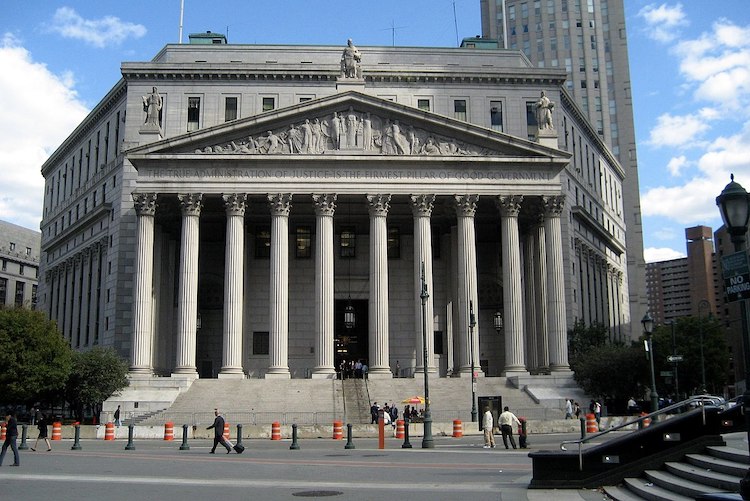The New York Commercial Rent Tax, also known as the CRT, is a tax charged to tenants who use or occupy a property for commercial activity in Manhattan, south of the center line of 96th Street, and pay at least $250,000 each year in rent. The tax rate is 6% of the base rent, and all taxpayers are granted a 35% base rent reduction, which reduces the effective tax rate to 3.9%. In addition, you are allowed a tax credit if your annualized base rent before the 35% rent reduction is between $250,000 and $300,000.

The CRT generates tax dollars that go to the City of New York and generates 1% of the city’s budget, which is approximately $700 million. However, there is a projected budget surplus of $2.5 billion dollars this year, which makes now a good time to eliminate this tax. The CRT is due annually on June 20th and quarterly on September 20th, December 20th, and March 20th each year.

Do it Yourself Wills and Living Trusts
Quicken WillMaker and Trust is an easy way to create your estate plan.
It is important to note that the CRT only applies to commercial tenants in Manhattan and not to residential tenants or those located in other boroughs of New York City. The CRT is a significant source of revenue for the city, but it also adds to the financial burden of businesses in Manhattan. Therefore, it is essential for businesses to understand the CRT and its impact on their bottom line.
Understanding Commercial Rent Tax
Definition and Scope
The Commercial Rent Tax (CRT) is a tax levied by the New York City Department of Finance on tenants who occupy or use a property for commercial purposes in Manhattan below 96th Street. The CRT is charged to tenants who pay over $250,000 in annual base rent before the 35% rent reduction and other permissible reductions, such as those allowable under the Commercial Revitalization Program.
The CRT is imposed on the tenant, not the landlord, and is based on the gross rent paid by the tenant. The tax is calculated as a percentage of the base rent paid by the tenant, with a base rate of 6%. However, all taxpayers are granted a 35% base rent reduction, which reduces the effective tax rate to 3.9%.
Tax Rate and Calculations
The tax rate is 6% of the base rent. All taxpayers are granted a 35% base rent reduction, which reduces the effective tax rate to 3.9%. In addition, you are allowed a tax credit if your annualized base rent before the 35% rent reduction is between $250,000 and $300,000. The tax is calculated based on the gross rent paid by the tenant, with allowable deductions for certain expenses.
The tax is payable quarterly, and returns must be filed with the Department of Finance. The tax year for CRT purposes is the same as the tenant’s income tax year.

Do it Yourself Wills and Living Trusts
Quicken WillMaker and Trust is an easy way to create your estate plan.
Tax Year and Filing Requirements
The CRT is payable quarterly, and returns must be filed with the Department of Finance. The tax year for CRT purposes is the same as the tenant’s income tax year.
In addition to the quarterly returns, tenants must also file an annual return with the Department of Finance. The annual return is due on the same date as the tenant’s federal income tax return.
Tenants who fail to file their returns or pay the tax on time may be subject to penalties and interest charges. It is important for tenants to keep accurate records and file their returns on time to avoid these penalties.
Overall, the CRT is an important tax for tenants who occupy or use a property for commercial purposes in Manhattan below 96th Street. Understanding the tax rate, calculations, and filing requirements is essential for tenants to avoid penalties and ensure compliance with the law.
Eligibility and Exemptions
Exempt Businesses and Premises
The Commercial Rent Tax (CRT) is charged to tenants who occupy or use a property for commercial activity in Manhattan, south of 96th Street. However, certain businesses and premises are exempt from the CRT. These include premises used for theatrical productions, premises occupied by certain not-for-profit organizations, and premises rented for periods of 14 days or less.

Do it Yourself Wills and Living Trusts
Quicken WillMaker and Trust is an easy way to create your estate plan.
Small Business Tax Credit
The Small Business Tax Credit was introduced on July 1, 2018, and is available to eligible small businesses that pay the CRT. To be eligible for the credit, a business must have a base rent of less than $300,000 and have a commercial activity in Manhattan, south of 96th Street. The credit is equal to 0.375% of the base rent and is capped at $25,000 per year.
Partial Tax Credit Eligibility
Tenants with a base rent of more than $250,000 but less than $300,000 are eligible for a partial credit. The credit is calculated as follows:
- 0.375% of the base rent for tenants with a base rent of $250,000 or less
- A proportionate amount for tenants with a base rent between $250,000 and $300,000
It is important to note that the base rent used for calculating the credit is before any reductions, such as those allowable under the Commercial Revitalization Program.
In addition to the above exemptions and credits, certain taxpayers may also be eligible for a reduction in the CRT based on their income factor. The income factor is calculated as the taxpayer’s gross receipts from all sources within the City of New York divided by the taxpayer’s total gross receipts. However, the reduction is only available to taxpayers who meet certain income threshold requirements.
Overall, it is important for lessees to understand their eligibility for exemptions, credits, and reductions under the CRT to minimize their tax liability.
Determining Taxable Rent

When it comes to determining taxable rent for the Commercial Rent Tax (CRT) in New York City, there are a few important factors to consider. This section will outline the key considerations in calculating taxable rent, including inclusions and deductions, as well as the rent factor and gross receipts.
Inclusions and Deductions
The first step in determining taxable rent is to understand what is included and what can be deducted. For the purposes of the CRT, the base rent subject to tax is the amount of rent paid by the tenant for the use or occupancy of the commercial space. This includes any rent paid for additional premises or subtenants.

MSI Aegis ZS Gaming Desktop
AMD Ryzen 7 7700, GeForce RTX 4060, 16GB RAM, 1TB SSD, RGB Fan Cooling, Wi-Fi 6E, Keyboard & Mouse Included, DIY Friendly
However, there are certain deductions that can be made from the gross rent paid. These include any rent paid by the tenant to sublet the space, as well as any rent paid by the tenant for the use of the space as a residence. Additionally, any rent paid by the tenant for the use of the space for non-commercial purposes can also be deducted.
Rent Factor and Gross Receipts
Once the base rent subject to tax has been determined, the next step is to apply the rent factor and gross receipts to calculate the final taxable rent. The rent factor is determined by the location of the commercial space. For spaces located south of the center line of 96th Street, the rent factor is 3.9%. For spaces located north of this line, the rent factor is 0.4%.
To calculate the final taxable rent, the base rent subject to tax is multiplied by the rent factor. The resulting amount is then multiplied by the gross receipts for the space. Gross receipts include all sales, services, and other receipts from the space, less any cost of goods sold.
In summary, determining taxable rent for the Commercial Rent Tax in New York City involves understanding what is included and what can be deducted from the base rent subject to tax, as well as applying the appropriate rent factor and gross receipts. By following these steps, tenants can ensure that they are accurately calculating their CRT liability and avoiding any potential penalties or fines.
Calculating CRT Liability

When it comes to calculating Commercial Rent Tax (CRT) liability, there are two main factors that come into play: total income and gross rent.
Income-Based Calculations
For tenants who have a total income of $5 million or less, the CRT rate is 3.9% of the base rent. This means that tenants who fall into this category will need to calculate their CRT liability based on their base rent and the 3.9% rate.
However, for tenants who have a total income of more than $5 million, the CRT rate is 4.425% of the base rent. This means that tenants who fall into this category will need to calculate their CRT liability based on their base rent and the 4.425% rate.
It’s important to note that the total income used to calculate CRT liability is the same as the total income used to calculate federal income tax liability. This means that tenants will need to ensure that they have accurate and up-to-date records of their total income in order to calculate their CRT liability correctly.
Rent-Based Calculations
In addition to income-based calculations, tenants may also need to consider rent-based calculations when calculating their CRT liability.
For example, if a tenant has subtenants or multiple premises, they may need to use a Finance Supplemental Excel Spreadsheet to report more than three premises or multiple subtenants.
Tenants may also be eligible for permissible deductions, including those allowed under the Commercial Revitalization Program. These deductions can be subtracted from the gross rent paid in order to calculate the base rent that is subject to the CRT.
Overall, calculating CRT liability requires careful consideration of both income-based and rent-based calculations. By accurately calculating CRT liability, tenants can ensure that they are meeting their tax obligations and avoiding any potential penalties or fines.
Credits and Reductions

CRT Credit
The Commercial Rent Tax (CRT) in New York City provides a tax credit to eligible tenants who have an annualized base rent between $250,000 and $300,000 before the 35% rent reduction. The CRT credit reduces the effective tax rate to 3.9%. Tenants with a base rent of less than $250,000 will not be subject to the CRT. The credit is calculated using a sliding scale based on the tenant’s annualized base rent. The CRT credit is a dollar-for-dollar reduction of the tax liability.
Commercial Revitalization Program
The Commercial Revitalization Program (CRP) is a tax abatement program that provides eligible tenants with an abatement of the CRT. The CRP abatement is available to tenants located within a CRP abatement zone. The CRP abatement is equal to 25% of the CRT liability, up to a maximum of $2,500 per year. The CRP abatement is in addition to the 35% rent reduction and the CRT credit.
Tenants who are located within a CRP abatement zone and have an annualized base rent of less than $250,000 before the 35% rent reduction are no longer subject to the CRT. However, a tax return may still be required to be filed.
Tax law changes may affect the eligibility for CRT credit or CRP abatement. It is important for tenants to stay informed of any changes to the tax law that may affect their tax liability.
Overall, tenants who are eligible for CRT credit or CRP abatement can benefit from significant reductions in their tax liability. It is important for tenants to understand their eligibility for these credits and reductions and to take advantage of them to reduce their tax liability.
Compliance and Penalties

Filing Returns
New York City commercial tenants subject to the Commercial Rent Tax (CRT) are required to file annual returns by June 20th each year. These returns can be filed electronically through the NYC e-Services portal or by paper. Tenants who file on paper must download the current tax forms and spreadsheets for additional premises and subtenants.
To ensure compliance, tenants must accurately report their gross rent and pay the appropriate amount of tax. The gross rent is the total rent paid by the tenant, including any additional rent paid to the landlord for taxes, utilities, and other expenses. Accuracy and completeness of the returns are essential to avoid penalties and consequences.
Penalty for Non-Compliance
Failure to file a return or pay the tax on time can result in penalties and interest. The penalty for late filing is $50 for each month or part of a month that the return is late, up to a maximum of $250. The penalty for failure to pay the tax on time is 1.5% per month, up to a maximum of 18% per year.
Tenants who fail to file returns or pay the tax on time may also be subject to additional consequences, such as liens on their property or legal action. It is essential to comply with the CRT requirements to avoid these consequences.
Waiver of Penalties
Tenants who are unable to file returns or pay the tax on time due to reasonable cause may request a waiver of penalties. The waiver request must be made in writing and include a detailed explanation of the circumstances that prevented compliance. The request must be filed within 30 days after the penalty is imposed.
The waiver of penalties is not automatic and is subject to review by the Department of Finance. Tenants who receive a waiver of penalties must still pay any interest due on the late payment of the tax.
Defending Tax Audits
Tenants who are audited by the Department of Finance must provide accurate and complete records to support their returns. The records must include leases, rent invoices, canceled checks, and other documents that support the gross rent reported on the return.
Tenants who are unable to provide accurate and complete records may be subject to penalties and additional taxes. It is essential to keep accurate and complete records to defend against tax audits.
Legal and Professional Considerations

Regulations and Legal Framework
The New York City Commercial Rent Tax is governed by Section 11-704.4 of the New York City Administrative Code. This code outlines the tax rate, base rent reduction, and tax credit available to taxpayers. It also provides limitations on the amount of tax that can be imposed on tenants paying less than $300,000 in annualized base rent.
It is important for businesses to understand the legal framework surrounding the Commercial Rent Tax to ensure compliance with the law. Failure to comply with the regulations can result in hefty fines and penalties. Therefore, businesses should seek the assistance of a tax professional or legal counsel to navigate the complexities of the tax law.
Seeking Professional Advice
Businesses should seek professional advice when dealing with the Commercial Rent Tax. A tax professional can assist in determining the amount of tax owed, identifying any exemptions or credits available, and ensuring compliance with the law.
Additionally, businesses should be aware of any changes to the tax law, such as the recent amendment that created a small business exception for businesses with total incomes of not more than $5 million and annual rents below $500,000. This exception can provide significant tax relief for eligible businesses.
The Internal Revenue Service also has guidelines on state and local taxes (SALT) requirements, which businesses should be aware of when dealing with the Commercial Rent Tax. These guidelines outline the limitations on the amount of SALT that can be deducted on federal tax returns.
In summary, businesses should be familiar with the regulations and legal framework surrounding the Commercial Rent Tax, seek professional advice when necessary, and stay up-to-date with any tax law changes or SALT requirements.
Special Situations and Additional Information

World Trade Center Area
The World Trade Center Area is exempt from the Commercial Rent Tax. The exemption applies to all buildings and properties located within the area bounded by the Hudson River, West Street, Vesey Street, and Broadway.
SALT Sales Tax Rules and Other States
New York’s Commercial Rent Tax is not the only state-level tax on commercial rent. Some states, such as Illinois and Maryland, also have a sales tax on commercial rent. In addition, some states have different rules regarding the taxation of commercial rent.
Commercial tenants need to be aware of these rules, as they may impact the amount of tax they are required to pay. In some cases, tenants may be required to pay tax in multiple states, which can complicate matters further.
Other Considerations
In addition to the above, there are a few other considerations that commercial tenants should be aware of when it comes to the Commercial Rent Tax:
- Gross Rent Paid: The Commercial Rent Tax is based on the gross rent paid by the tenant. This includes not only the base rent, but also any additional charges such as sewer charges and insurance.
- SAAS: Some commercial tenants may be eligible for the Small Business Alternative Sales Tax (SAAS) program. This program allows eligible tenants to pay a reduced rate of tax on their commercial rent.
- SAAS in Maryland: In Maryland, the SAAS program is only available to certain eligible tenants. Tenants must meet certain criteria, such as having fewer than 25 employees and occupying less than 5,000 square feet of space.
Overall, commercial tenants in New York City should be aware of the Commercial Rent Tax and how it may impact their business. By understanding the rules and regulations surrounding the tax, tenants can ensure that they are in compliance and avoid any potential penalties or fines.
Frequently Asked Questions

How is the base rent calculated for the purpose of NYC commercial rent tax?
The base rent for the purpose of NYC commercial rent tax is calculated by taking the gross rent paid for the entire year and subtracting any rent paid for space used for storage, manufacturing, or processing. The remaining amount is the base rent that is subject to the commercial rent tax.
What is the current commercial rent tax rate in New York City?
The current commercial rent tax rate in New York City is 6% of the base rent. However, all taxpayers are granted a 35% base rent reduction, which reduces the effective tax rate to 3.9%.
Who is responsible for paying the commercial rent tax in NYC?
The commercial rent tax in NYC is the responsibility of the tenant who occupies or uses a property for commercial purposes in Manhattan, south of 96th Street. The landlord is responsible for collecting the tax from the tenant and remitting it to the city.
Are there any exemptions available for the New York commercial rent tax?
Yes, there are exemptions available for the New York commercial rent tax. For example, small businesses with annualized base rent of less than $250,000 are exempt from the tax. Non-profit organizations are also exempt from the tax.
How can I calculate my NYC commercial rent tax liability?
To calculate your NYC commercial rent tax liability, you need to first determine your base rent by subtracting any rent paid for space used for storage, manufacturing, or processing from the gross rent paid for the entire year. Then, apply the commercial rent tax rate of 3.9% to the base rent to determine your tax liability.
What are the filing requirements for the NYC commercial rent tax return?
The filing requirements for the NYC commercial rent tax return depend on the amount of commercial rent tax due. If the annual commercial rent tax liability is less than $3,000, the taxpayer can file and pay the tax annually. If the annual commercial rent tax liability is $3,000 or more, the taxpayer must file and pay the tax quarterly.





